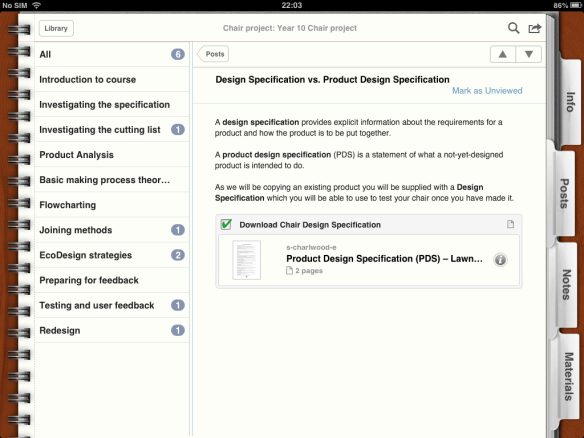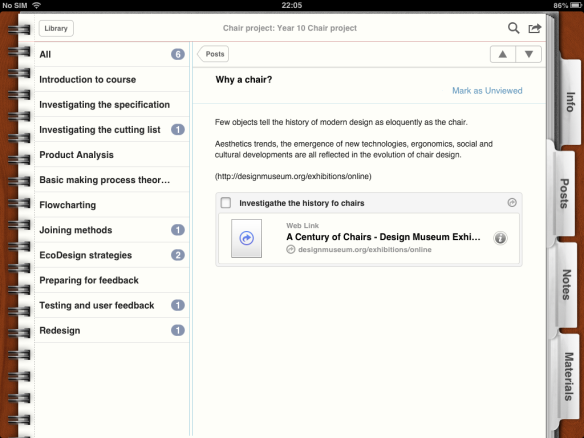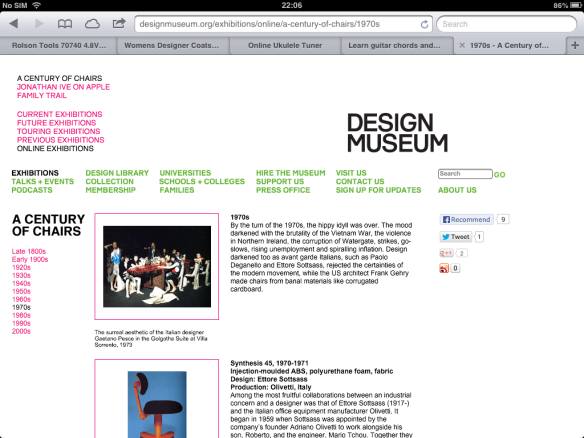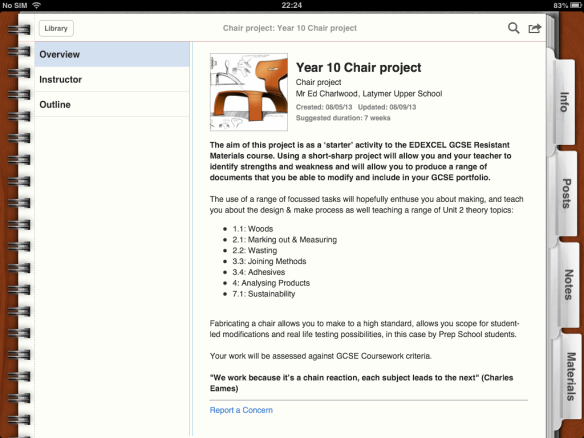This blog post is from David Barlex and Ed Charlwood and will be posted here (https://dandtfordandt.wordpress.com/) and on Ed’s blog (see http://mrcharlwood.blogspot.co.uk and @mrcharlwood). It is the result of two concurrent influences. Ed Charlwood has just become an Apple Distinguished Educator and David Barlex is working with Alice Hudson, head teacher of Twyford School on developing a creativity and curiosity curriculum. Hence we are both interested in the potential of Technology Enhanced Learning (TEL). But before we rush headlong into adopting new and almost certainly expensive approaches we think it is important to identify the substance of the learning, indicate clearly the activities that will enable this learning and show how various forms of technology will enhance that learning.
We begin by thinking about the way in which a typical unit of work is developed. The teacher would probably identify a sequence of activities that she could orchestrate to provide the necessary learning. It would be possible for these activities to be conventional in the extreme and involve PowerPoint or Keynote presentation driven lessons accompanied by various worksheets. Within the confines of this conventional approach new technology can be used apparently to enhance learning.
In a Design & Technology context it might be used, for example, to replace traditional skills, as in the use of the almost ubiquitous laser cutter, to cut shapes from acrylic as opposed to cutting them by hand, perhaps to make key rings. The result of this is a superficially enhanced end product but not necessarily with an improvement in design skill or an enhanced understanding of design process. When we cry out for more creativity from students we contradict ourselves by offering the same, safe, procedural challenges, albeit enhanced with expensive technology substitutions.
So the question becomes how are we to use technology enhanced learning to move away from conventional approaches without falling into the inadequate ‘replacement trap’ described above? This is where Ed’s work with Apple comes into play. He learned about the framework for introducing technology enhanced learning devised by Dr Ruben Puentedura. It is in two parts; “enhancement” and “transformation” and uses the acronym SAMR.
Enhancement consists of Substitution and Augmentation.
Transformation consists of Modification and Redefinition.
In substitution, technology acts as a direct tool substitute, with no functional change.
In augmentation, technology acts as a direct tool substitute with functional improvement.
In modification, technology allows for significant task redesign.
In redefinition, technology allows for the creation of new tasks previously inconceivable
So an immediate question for David is:
“If we are developing a creativity and curiosity curriculum how do we move from enhancement to transformation?”
One way to answer this question is to consider a typical Design & Technology unit, one for example which requires students to acquire sufficient knowledge, understanding, skills and values to design and make a working prototype of some furniture for a kindergarten.
At this point, you may like to enroll to the iTuneU course Ed has created to employ some of the possibilities that new technologies promise. To do so, download the iTunesU app on an iOS device (iPad, iPhone,iPod) and follow this link: https://itunesu.itunes.apple.com/enroll/DJX-XLW-JN2
If you do not have the facilities for doing this, we will pick out individual elements of the course (with screenshots) and address how they relate to the aforementioned SAMR model.
Example 1: Substitution
A specification worksheet is available for download from the iTunesU course as opposed to the teacher photocopying the class a set. There is a short introduction, probably along the same lines as what the teacher would say.
While there are workflow benefits for the teacher and the students (no photocopying, no lost sheets) the task itself is not hugely enhanced.
Example 2: Augmentation
Providing access to the link for the Design Museum chair exhibition and asking students to annotate voice notes on a personal favourite, augments the traditional task of say, looking in a book.
This could also be used as an interesting starter activity; ask the student to pick a chair and be ready to contrast it with one you have on display. You will get a richness and breadth of response impossible if they were using your information sheets.
However, will this ‘democratization’ of information be a challenge to you?
In this case there are again obvious functional benefits; paper saving for example but additionally the richness of the information available will enhance engagement as the focus of the enquiry moves away from being ‘teacher centric or teacher owned’.
Example 3: Modification
The traditional model would see a teacher demonstrating a skill like making a mortise and tenon joint and the students copying it in the master / apprentice relationship of traditional martial arts films.
In this task we challenge the students to research and select a suitable joining technique from a PDF and to record the process of making it using iMovie. This task offers significant functional change and the teacher/student relationship is akin to mentor / hero of Yoda and Luke Skywalker in Star Wars.
In the modified example the woodworking skills the students are learning are similar but the technology input facilitates rich peer and teacher feedback opportunities. Self-reflection by the students will be absolutely necessary to narrate or annotate the video.
 So we have reached the point where we have a substantially different Year 10 Chair project.
So we have reached the point where we have a substantially different Year 10 Chair project.
Example 4: Redefinition ???
We have demonstrated how it is possible to significantly alter the tasks that are taking place in a unit of work by using the iTuneU approach. The teacher/student class/home boundaries are blurred and there is likely to be increased engagement accompanied by improved logistics.
However we must ask if this approach has resulted in true redefinition of the current task such that it is completely different in character from the original task from which it was derived? We have to acknowledge that this is NOT the case.
Of course this does not mean that the three stages of substitution, augmentation and modification are not worthwhile. On the contrary, these are not only worthwhile but the change in the nature of the tasks and the scaffolding possible via an iTunesU approach, such as this, manages the risk associated with the introduction of Technology Enhanced Learning.
But it does mean that we have not taken the use of Technology Enhanced Learning to its limits. We are coming to the conclusion that redefinition is unlikely to take place unless the task is a new conception from the outset i.e. it is not derived from a current task. This represents a considerable challenge.
We suggest two approaches to address this.
One has been developed by the Design & Technology Association. This is the Open Starting Points approach. These starting points are available as visual brainstorms, which the teacher can use with the class to explore the context and identify many different sorts of product that could be designed and made in response. These open starting points provide the opportunity to give pupils a voice as to what sort of product they want to design and make and how they might go about the task. The exact nature of the products designed and made will depend on the age and previous experience of the pupils and the resources available in the school. How they think they should tackle the task will depend on their previous exposure to Technology Enhanced Learning.
Taken together these are a strong example of a partnership curriculum in which teachers and pupils are engaged in a process of negotiation. This is likely to develop completely new tasks and give the pupils a voice that will increase their influence on the curriculum and provide ownership, which is likely to increase their motivation. The open starting point brainstorms are available at http://www.ectcurriculum.org/index.php/starting-points/very-open.
Another way is the Challenge Based Learning process promoted by Apple and described here http://www.apple.com/uk/education/challenge-based-learning/. The Challenge Based Learning process begins with a big idea and cascades to the following: an essential question, a challenge, guiding questions, activities, resources, determining and articulating the solution, taking action by implementing the solution, reflection, assessment, and publishing. All these stages are supported with Technology Enhanced Learning.
So in answer to our original question “Technology Enhanced Learning in Design & Technology – Yes or No?” we say “Yes” and believe that it is possible to do this in relatively easy stages that are manageable with only minimal risk to student learning and the potential for huge gains. Attempting redefinition as a first step would be unwise but as an ultimate goal it is definitely both feasible and desirable.





You must be logged in to post a comment.